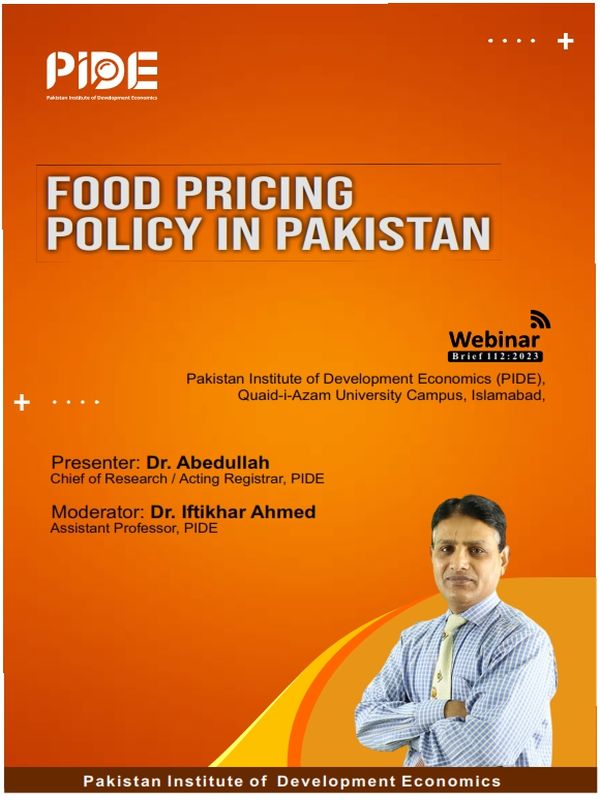Food Pricing Policy in Pakistan
Moderator: Dr. Iftikhar Ahmed, Assistant Professor, PIDE
Presenter: Dr. Abedullah, Chief of Research / Acting Registrar, PIDE
In Pakistan, input subsidies and price support are the basic tools used for pricing policy. However, if these tools are implemented in the proper way, they may affect the economy positively. Some of the harmful implications of these tools are as follows:
- If govt. set prices below the equilibrium there will be a shortage of food, and if they select prices above the equilibrium there will be a surplus of food.
- Giving high subsidies will discourage foreign investment, as in the case of 200 billion fertilizers subsidies in terms of cheap gas. The foreign producer is reluctant to come because they can’t compete in the local sector.
- The cost-benefit analysis shows that a 200 billion investment in terms of wheat subsidy, on average, benefited about 75 rupees a five-member family per month. It means these interventions are too much costly against the investment.
- These high subsidies may sometime result in a negative effect on productivity. When govt. provides a subsidy on one food, the farmers are reluctant to grow other crops, e.g., fruit and vegetables. That’s the reason that our imports of edible crop are almost 4.5 billion per annum.
- These tools may create the problem of inequality. The large farmer gets more subside and more benefits than the small farmer.
So sometimes, govt. interventions may create problems. Certain price regulation acts in Pakistan allow govt. to intervene in the market. If we want to minimize government intervention in the market, we have to make changes in these acts.
Importance
Food inflation is very important to be controlled. Although the price of other commodities is also increasing, food is consumed by everybody, so it affects every individual. So it needs to be controlled.
“Nothing can bring people into the street faster and more spontaneously than a rapid run-up in the cost of food.”
(Prof. Peter Timmer, Harvard University)
Process
- Prices are collected from four mega cities(Islamabad/Rawalpindi, Lahore, Multan, and Faisalabad) for some essential commodities.
- On average, six retailers are chosen two are supplying commodities to high-income group people, two are supplying to middle income, and two retailers are supplying commodities to low-income people.
- The data on DCO prices is also collected to see the difference between DCO prices and Farm gate prices. The data is collected for ten consecutive days.
Comparison between Farm gate price and DCO price
The difference between the DCO prices and Farm gate price are an average of 10.5% (varying from 6.3% to 20.3%). This means that DCO prices are not intervening anywhere in Pakistan if we bind the retailer to sell at DCO prices which is not even possible at all because of the other related cost (labor costs and transportation costs) faced by the retailer. High-income people want a high-quality product, and normal and middle-income people do. The DCO prices will kill the variation in the supply of products; ultimately, it will support the lemon market.
Pakistan Bureau of Statistics (PBS)
The price generated by PBS is very important as businessmen, and investors use it to decide what to grow, what not, where to invest, and what to preserve for the future, etc. However, they generally show underpricing in order please the govt. For example, PBS gives the maximum retail price for wheat from 2021-2022 as 86.9/ kg, but in reality, in the market, it goes approx. 110/KG. So it means they are underreporting.
Evaluation of Govt. Footprint in the Wheat market.
As govt. is paying 55 Rs/Kg to the farmer after adding the other cost of storage and transportation etc., it costs about 70Rs/kg, but in the market, the price is 110Rs/Kg. So even if they add 10Rs of profit still, the price difference is large. The reason given by officials for this huge difference is demand shock. As demand is high, supply is low, so govt. imports from foreign at 82Rs/kg, and after adding the other cost, it goes to 90Rs/Kg but still, in the market, the price is 110Rs/Kg, which is the high price. So it means govt. is not performing its duty well. Govt. is spending 131 billion on this activity without generating any benefit to producers and consumers. If this activity is done under the private sector, then govt. can at least save this 131 billion. So as a solution to this, if the price in the local market increases beyond 25% of the international market, only then govt. should have the right to intervene.
| Year
(2017-2018) |
Profit | Cost |
| 2020 | -17 | 19.7 |
| 2021 | -4.2 | 42.1 |
| 2022 | 47.2 | 79.9 |
Cost Benefit Analysis of Wheat
Values are representing the percentage change compared to the previous year.
Over the years the MSP does not grow as much as the increase in the cost of production ultimately compromises the productivity of wheat growers.
Conclusion
Government footprints in the food market are costly and inefficient. So when we are saying wheat prices are increasing, it is not just because of inflation only we also need to look at the source of inflation. We believe that competition in the food market will help lower prices and allocate resources more efficiently.




